Glove Properties
When looking at exam gloves, you will notice different characteristics of exam gloves that can make your shopping experience quite mind-boggling. You will see that some properties will be requirements while others may be considered to be "nice to haves".
 Material Composition
Material Composition
In general, exam gloves will be made from latex, vinyl, nitrile, or a combination of the materials. There are other gloves that use other raw materials like neoprene or polyisoprene. However, due to the high cost of these materials, it is not common to find exam gloves being composed of these materials.
The cost of gloves will vary based on efficiency of factories and the cost of production and raw materials. The different costs among latex, vinyl, and nitrile is primarily due to the differential seen in the price of raw material. The manufacturing process is nearly identical for all exam glove types.
Powder vs Powder-Free
Nearly all gloves produced today are powder-free. Powdered gloves are generally cheaper than their powder-free counterparts because additional steps are required in the manufacturing process to make the glove powder-free.
Color
Exam gloves can be found in numerous colors like blue, purple, green, or black in addition to the traditional white. In general, you will find nitrile exam gloves to be purple or blue while vinyl gloves remain a white hue. It is important to note that the color of an exam glove does not determine the material composition nor a safety level.
Texture
Another key physical characteristic of medical gloves is texture. Textured gloves are typically preferable to prevent slippage especially when handling moist or wet objects. Textured gloves are typically found either on the fingertips or completely (all over the glove). In general, vinyl gloves are not textured because the raw material (PVC) does not make manufacturing textured gloves easy. Textured versions of gloves can be found in Latex or Nitrile gloves. Today, you will find more textured gloves as these are generally preferred over their smooth counterparts.
Thickness
Arguably the most important glove property will be the thickness of the glove. Thickness is measured typically in milimeters, or "mils". The thickness of gloves may differ throughout the glove, but the most important areas to look are the fingers and palm. Thickness will typically determine the level of protection against chemical agents; however, just because a glove is thick does not mean the glove will provide adequate protection. Glove manufacturers can provide chemical test data so you can select the best glove for your needs.